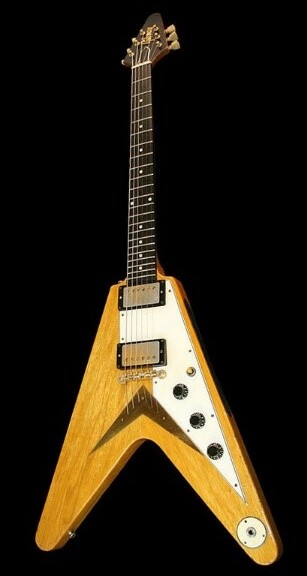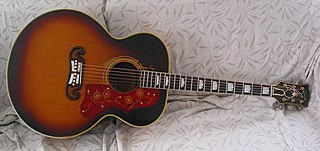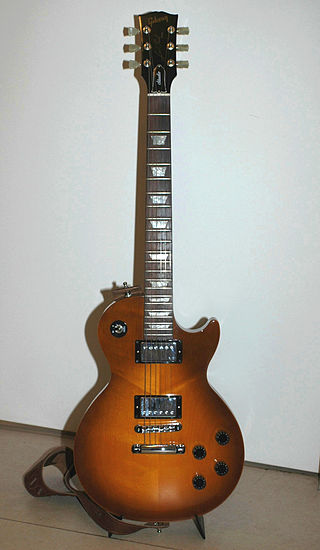
Pearloid is a plastic that is intended to resemble mother of pearl. It is commonly used in making musical instruments, especially for pickguards, electric guitar inlays, and accordions. [1]

Pearloid is a plastic that is intended to resemble mother of pearl. It is commonly used in making musical instruments, especially for pickguards, electric guitar inlays, and accordions. [1]
Pearloid is produced by swirling together chunks of celluloid in a solvent, then curing, which gives it a mother of pearl effect. [2] It is sliced and bonded to or inlaid in other materials, such as the wood of guitar necks. [2]
Pearloid is used in any context where genuine mother of pearl or abalone might be used, as it is much cheaper and doesn't deplete the supply of the natural material. Gibson uses it as a substitute for the mother of pearl inlays in the fretboards on most of its guitars. [3] Various colored versions are often used on items intended to have a retro appearance. [4]

The Gibson SG is a solid-body electric guitar model introduced by Gibson in 1961, following on from the 1952 Gibson Les Paul. It remains in production today in many variations of the initial design. The SG Standard is Gibson's best-selling model of all time. SG stands for "solid guitar".

Nacre, also known as mother of pearl, is an organic–inorganic composite material produced by some molluscs as an inner shell layer. It is also the material of which pearls are composed. It is strong, resilient, and iridescent.

The Gibson ES-335 is a semi-hollow body semi-acoustic guitar introduced by the Gibson Guitar Corporation as part of its ES series in 1958. It features a solid maple wood block running through the center of its body with upper bouts that are hollow and two violin-style f-holes cut into the top over the hollow chambers. Since its release, Gibson has released numerous variations of and other models based on the design of the ES-335.
The Fender Jaguar is an electric guitar by Fender Musical Instruments characterized by an offset-waist body, a relatively unusual switching system with two separate circuits for lead and rhythm, and a short-scale 24" neck. Owing some roots to the Jazzmaster, it was introduced in 1962 as Fender's feature-laden top-of-the-line model, designed to lure players from Gibson. During its initial 13-year production run, the Jaguar did not sell as well as the less expensive Stratocaster and Telecaster, and achieved its most noticeable popularity in the surf music scene. After the Jaguar was taken out of production in 1975, vintage Jaguars became popular first with American punk rock players, and then more so during the alternative rock, shoegazing and indie rock movements of the 1980s and 1990s. Fender began making a version in Japan in the mid-1980s, and then introduced a USA-made reissue in 1999. Since then, Fender has made a variety of Jaguars in America, Mexico, Indonesia and China under both the Fender and Squier labels. Original vintage Jaguars sell for many times their original price.

The Gibson Flying V is an electric guitar model that was originally introduced by Gibson in 1958. The Flying V offered a brand new, radical, "futuristic" body design, much like its siblings: the Explorer, which was released the same year, and the Moderne, which was designed in 1957 but not released until 1982. The initial run of guitars used a distinctive wood of the Limba tree marketed by Gibson under the trade name "korina"; later models used more conventional woods.
The King V is an electric guitar model made by Jackson Guitars.

A pickguard is a piece of plastic or other material that is placed on the body of a guitar, mandolin or similar plucked string instrument. The main purpose of the pickguard is to protect the guitar's finish from being scratched by the nails of the picking hand, as it was included on guitars not played with a plectrum. The pick does not normally contact that part of the guitar when used correctly.

The G-400 is an Epiphone solid body electric guitar model produced as a more modestly priced version of the famous Gibson SG. Currently, Epiphone is a subsidiary of Gibson and manufactures the G-400 and other budget models at a lower cost in Asia. Visually and ergonomically, it is almost identical to a 1962 SG.

The Gibson ES-125 is an archtop, hollow body electric guitar model that was produced by the Gibson Guitar Corporation.

The Gibson J-200, is an acoustic guitar model produced by the Gibson Guitar Corporation.

The Gibson Hummingbird is an acoustic guitar model/series produced by the Gibson Guitar Corporation.

Inlay on guitars or similar fretted instruments are decorative materials set into the wooden surface of the instrument using standard inlay techniques. Although inlay can be done on any part of a guitar, it is most commonly found on the fretboard, headstock—typically the manufacturer's logo—and around the sound hole of acoustic guitars. Only the positional markers on the fretboard or side of the neck and the rosette around the sound hole serve any function other than decoration. Nacre, plastic and wood are the materials most often used as inlay.

The Fender Jaguar Bass is an electric bass guitar currently manufactured in Mexico by the Fender Musical Instruments Corporation.

The Fender Coronado is a double-cutaway thin-line hollow-body electric guitar, announced in 1965. It is manufactured by Fender Musical Instruments Corporation. The aesthetic design embodied in the Coronado represents a departure from previous Fender instruments; the design remains an uncharacteristic piece of Fender history.

The Gibson Les Paul Studio is a solid body electric guitar produced by the Gibson Guitar Corporation since 1983. It is a model of Les Paul with some features omitted to appeal to musicians looking for the tonal qualities of the guitar but with less of an emphasis on cosmetics and to reduce the price of the instrument.

The Gibson Dove is a flattop steel-string acoustic guitar made by the Gibson Guitar Corporation since 1962.

Duesenberg is a brand for electric string instruments founded in 1986 and located in Hannover, Germany. The headquarter is in Hannover, Germany, they are known for using a Plek machine for the levelling of frets and setup. Duesenberg has uploaded a factory production video of how their guitars are made, revealing that most of the production of the guitars is done in Croatia, while the final setup and assembly is done in Germany.

The Gibson ES-333 is a semi hollow body electric guitar made by Gibson Guitar Corporation.

Sigma Guitars is a guitar manufacturing brand originally released by C.F. Martin as a line of guitars at affordable prices to compete with the increasing number of imported guitars from Japan and elsewhere. The Sigma line was discontinued by Martin in 2007. The rights to the name were acquired by German company AMI Musical Instruments GmbH, which relaunched the brand with guitars being produced in China.